Tips to see the Auroras
Tips to see the Auroras The Auroras (Australis and Borealis) happen during Earth’s day and night time. They are one of the wonderful ways in which Nature shows-off its beauty and supremacy; and they are definitely a must-see, at least once in your lifetime. To see them, here are some tips to keep in mind: Geomagnetic activity If the geomagnetic field of the Earth is active, which is determined by solar activity, then the auroras will be brighter and move further away from the poles. The level of geomagnetic activity is measured by the planetary K or «Kp» index, which ranges from 0 to 9. Kp from 0 to 2: there won’t be much activity; near the poles; dim intensity. Kp from 3 to 5: there shall be more activity, both in formations and motion; they will be moving further from the poles; brighter. One can pleasantly observe them from the right places. Kp from 6 to 7: active and with formations and motion; they go further away from the poles; quite bright. Kp from 8 to 9: very active; they go further from the poles and towards the equator; very bright. This Kp shows when big solar storms happen (G5), they have the best visibility and one can see the best dancing auroras. The auroral oval can normally be observed from many places on Earth. Location, light and timing Location: It is important to be in the poles or close to them. With an unobstructed view and facing the the direction of the aurora, it can be seen up to 1000 kilometres away. From the right place, it can even be properly observed from Kp3, as stated by NOAA. Light: It must be dark. It is rare to be able to spot the lights during our daytime, even if the auroras happen in both our days and nights. The light of the Sun can block the possibilities of seeing them during the day, so one should go at night. A full moon can also lower the chances of seeing the lights. Avoid big cities and even civilization, as light pollution can also diminish the likelihood of enjoying them. Timing: Two factors are important in this section: time of the year and hour of the night. The auroras show in the poles of our planets, where we have long summer days and long winter nights, therefore winter being the best time to go. It is important to consider that it is also winter the season in which meteorology shows us best how our skies can be covered by clouds, rain or snow, so it is good to check the weather forecast. In the Northern Hemisphere, the best time to spot them would be between August and April, and in the Southern Hemisphere between April and October. Regarding the time of the night, it is believed that the best time is one or two hours before and after midnight (which translates into 10 pm to 2 am local time). In any case, between dusk and dawn. Opportunity and preparedness What a bummer it would be to prepare a trip at the right time, right destination, and not be lucky enough to see them. Unfortunately, that can happen. So always take advantage of all opportunities that may cross your way. Plan a longer time in the region, do your research and prepare. Be willing to stay awake all night -or many hours to say the least-. The eye also needs to adapt to the darkness, to observe the skies, to learn and know what to look for. Be patient, as their motion and movement can make them «come and go». Wear really warm clothes and layer up (so you can also layer down if needed). One of my biggest tips in this section: wool. Merino wool if possible. Wool helps regulate temperature, keeping you cool when it warms up and keeping you warm when it cools down. An inner layer of breathable technical thermal clothing can be ok too. Yet I insist: wool. Avoid cotton, as it tends to cool down and it is not very comfortable once one starts to sweat. Down coats are wonderful to keep you warm (in my top two types of coats I have ever owned!). It is crucial that the outer layer (insulate or thinsulate) is wind and waterproof, both bottoms and top. Don’t forget a good hat (which covers the ears), a neck gaiter (wool!), gloves, socks (wool!) and good winter shoes. Making sure we are well-dressed for the cold is crucial to avoid getting sick and to be able to be exposed to the cold weather that usually accompanies these sightings. If you own a DSLR camera or a mobile phone which can be put into manual settings, learn how to use them and shoot raw. If you have a smartphone and do not know how to use manual mode or just want to capture something «quick» for the memories, remember to activate «night mode» so the phone calculates exposition and balance on its own. Bring an extra portable charger with you (power bank) just in case – cold climate makes batteries last less time. Bring some food and drinks to keep you warm, and enjoy. The Auroras are a phenomenon to observe patiently and joyfully, being in awe with Nature. Important IMPORTANT: Due to the fact that this is a natural occurring phenomenon, it is never 100% possible to guarantee visibility. I was recently asked «are you sure that they will be seen?», and I responded «it is Nature, no one can ever be sure». These are mere guides, based on science, probability and experience, which can help us to enjoy our beautiful Nature. 🇮🇨 tbt con @tenoactivo explorando y aprendie It's always summer somewhere 🩵 [🇪🇸 debajo ¿Y por qué no un poquito de Europa central este 🍺 "I don't do beer" 🍻 [español debajo] 🇩 [English below] 🇮🇨 Pedazo de fin de semana c Emiratos Árabes Unidos 😍🇦🇪 (English belo First glimpses
Los Indianos, the must-do party on the island of La Palma
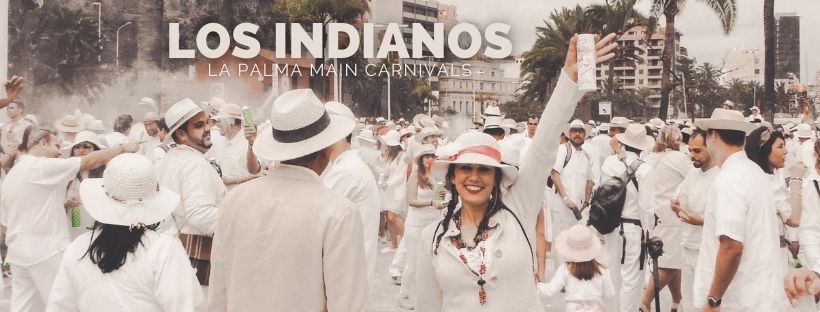
Los Indianos, the must-do party in La Palma «Al carnaval palmero me voy, donde mejor se puede gozar» «To the carnival of La Palma I am going, for it is the best place to have a blast» – that’s part of the lyrics of a song that palmeros (islanders from La Palma) sing during that day: the first Monday of carnivals in the Canary Islands. Back in the XVI century there was a back-and-forth movement of people between Latin America and the Canary Islands which gave place to exchange, legacy and creation of wonderful traditions which tie both cultures. Language is shared, with words like guagua (bus), cotufas (pop-corn), or habichuelas (green beans), which are called differently by the rest of Spaniards yet Canarians do share with Latin Americans. Even the music and the rhythm which Canarians carry in our blood and emit like fire coming from our salty core. The island of La Palma is also proof of that. It was during one of those back-and-forth travels that some sailing boats arrived to la Isla Bonita («the beautiful island», name that is given by Canarians to the island of La Palma for its incredible beauty, constant greenery and astonishing orography). From the capital, Santa Cruz de La Palma, islanders were being observed arriving from Cuba, showing off their wealth: the ladies with their white lace garments and sumptuous jewelry, the gentlemen with their Panamian hats and flax apparel… Bags, luggage, trunks, cigars and complements which they proudly showed, coming back from «sister Cuba». The palmeros who saw them from afar, ran to the docks to receive them, paralyzing the city, due to their festive and curious spirit. Streets were crowded and noisy, fires were made, music was played, a welcoming celebration for the ones who came back commenced in the streets. Locals and new-comers, with their cigars, profiteroles, honey and cane rum, danced to Caribbean tunes: la habanera, el son, la guaracha, la guajira. Years passed, and it was in the 1920s that a group of friends who met in the humorous society of La Poteca, started their parade of Indianos, to commemorate the said historical moments of the compatriots arriving from the lands far far away. They were known as discreet and witty people with a good mood and great vibes, ready for everything – especially to eat and drink without any issues at all! Years later, and already in the 60s, the parade became a party and thenceforward, part of the Carnaval Palmero (Carnival of the island of La Palma), having that celebration institutionalized in the evening of the famous lunes de carnaval (Monday of carnival, one of the biggest days of these celebrations in the islands). Nowadays, Canarians from all islands make their way to Los Indianos on the lunes de carnaval, and it is the most recognized, appreciated and looked-forward-to party by many. People dress in white, mimicking the ones who returned from Cuba, carry and throw talcum powder, and Canarians go via land, ocean and air, to celebrate the hispano-american migration which has known how to coexist during all these years, with affection, fun and good vibes. Here are some images of this Carnaval for all ages: From the moment you get to Santa Cruz, the environment reflects happiness, community and healthy fun Los Indianos is an event for all ages, from the little ones to the elderly, everyone participates in this white celebration There are trucks from which talcum powder is distributed so everyone can have some Plaza España (Spain square) becomes Plaza de La Habana during the celebrations With La Negra Tomasa With «La Negra Tomasa» (the black Tomasa), symbolic character of the carnival parody of Los Indianos. The face behind the character Víctor Lorenzo Díaz, receiving a Gold Insignia from Santa Cruz de La Palma for his joyful commitment to this party The streets become white. Locals and visitors share good vibes, good times, socializing, celebrating the union of the peoples Friends in Los Indianos To go to Los Indianos by air: Binter and Canaryfly fly between islands. To go by sea: Naviera Armas and Fred Olsen sail between islands. DO NOT FORGET: respect the party and its tradition, dress white, byo hat, and don’t forget to play and enjoy, throwing and receiving (not in the eyes) talcum powder! 🇮🇨 tbt con @tenoactivo explorando y aprendie It's always summer somewhere 🩵 [🇪🇸 debajo ¿Y por qué no un poquito de Europa central este 🍺 "I don't do beer" 🍻 [español debajo] 🇩 [English below] 🇮🇨 Pedazo de fin de semana c Emiratos Árabes Unidos 😍🇦🇪 (English belo First glimpses of UAE ✨ Primeros vistazos de Emi Follow me on Instagram
Best spots to Surf and Bodyboard in Tenerife
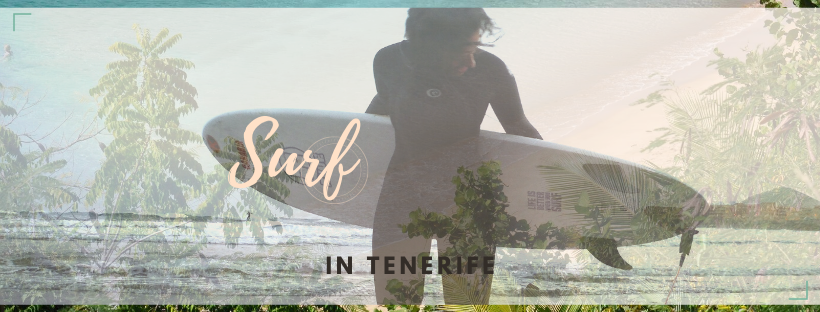
The Canary Islands are a mini paradise for surfing and bodyboarding. World championships are held in some of the islands’ best spots every year. Catching some waves is one of the top activities to do in the island of Tenerife, the one of greatest relief, as it offers a vast choice of beaches to slide off the adrenaline rush. The island is set in a privileged area, being part of the Macaronesia, in the Atlantic Ocean. The winds, temperatures and types of seabed, offer different kinds of waves for all surfers, from the foam for the newbie to the highest peaks for most experienced ones. Below, I list a few of the best beaches I personally know for these two sports. Please, be cautious, respect the sea, and good waves for all 😉 ANAGA AREA Almáciga The first time I got on a surfboard, it was a tiny fish board and right on this beach. Sweet memories playing with the waves and discovering how unstable those boards are… especially for beginners! Access and services: Wild beach. Parking in front of the beach. Refreshments stand. From the capital, you must take TF1 towards San Andrés, and right before entering the village, take left on the roundabout. Go up on that road and take the second exit towards «Taganana/ Almáciga» (TF12). After Taganana and Roque de las Bodegas, you’ll find Almáciga beach. [su_gmap width=»50″ height=»50″ address=»Playa de Almáciga, Tenerife»] Municipality: Santa Cruz de Tenerife. Seabed: black sand. Direction of the wave: right and left. Wave characteristics: barrel, wall. Recommendation by ability level: intermediate and advanced. Warning: strong current area. Dangerous. Do not go away from the shore. Check weather and tides before going in the water. Benijo From my perspective, this is one of the most beautiful beaches of the island. Wild. A local gem. A wonderful beach where to spend the day or the evening (especially with receding tide), and watch the sunset. Access and services: No services and no parking. About 45-50 minutes away from the capital (27-28 km). After Taganana and Almáciga (check directions above), you’ll find a curve to the right. Next to the restaurant El Mirador, under the caserío de Benijo, you’ll find a pathway and some stairs that will take you to the beach. This may be my favorite or one of my favorite beaches. Please, take care of it! [su_gmap width=»50″ height=»50″ address=»Playa de Benijo, Tenerife»] Municipality: Santa Cruz de Tenerife. Seabed: black sand. Direction of the wave: right and left. Characteristics: wall. Recommendation for ability level: intermediate and advanced. Warning: strong current area. Dangerous. Do not go away from the shore. Check weather and tides before going in the water. NORTH (TF5) El Socorro (Realejos) Home to many competitions, this beach is perfect for bodyboarding, and as a good friend and boogie-boarding mentor of mine would say, wonderful for duck-dive practice! It may probably be the beach where I have practiced them the most, due to the speed of the wave series. Access and services: isolated beach. Parking (usually full). Toilet, wifi area, and a chiringuito (local beach-style food ‘n drinks stand). Disabled accessibility with reserved parking, access ramp and wheelchair friendly. In Los Realejos (after La Orotava), about 35 minutes away (42ks) from the capital. Access by car via TF5 and then main road c820, towards Mirador de San Pedro. [su_gmap width=»50″ height=»50″ address=»Playa de El Socorro, Realejos, Tenerife»] Municipality: Los Realejos. Seabed: black sand. Direction: right and left. Characteristics: quick wave, barrel, wall. Best tide: all. Recommended level: intermediate and advanced. Warning: strong currents and strong waves. Martiánez Close to Lago Martiánez, this beach is the most accessible -and very popular- by Puerto de la Cruz. You’ll find it right in front of the main avenue, where there is also a skate park. Surfing and bodyboarding championships are held on this beach. Access and services: right from the city. Access right at the entrance of Puerto de la Cruz, exit 32 of TF5, about 35 minutes (37ks) from the capital. When getting off the highway, continue towards Avenida de Colón; and if it is easier for you, follow the directions towards Lago Martiánez – when facing the ocean, it will be on its right hand. [su_gmap width=»50″ height=»50″ address=»Playa de Martiánez, Tenerife»] Municipality: Puerto de la Cruz. Seabed: sand and callao (a type of small stone). Direction: right. Characteristics: smooth. Best tide: high and mid. Recommendation: beginner and intermediate. *Tip: You will find surf schools here. SOUTH (TF1) El Socorro (Güímar) Callaos (stones) beach for bodyboarding. You’ll find locals. Access and services: in the coast of Güímar, close to the Malpaís (natural reserve), about 20 minutes (23 ks) from the capital. Take exit 20 when leaving highway TF1. [su_gmap width=»50″ height=»50″ address=»Playa de El Socorro, Güímar, Tenerife»] Municipality: Güímar. Seabed: stones and rocks. Direction: left. Characteristics: wall. Recommendation: intermediate. Playa El Faro – Playa Grande (El Porís) Beautiful beach by a fishermen’s village where you can eat really good fish. Mostly locals. Access and services: close to El Porís and a windfarm. Parking. About 35 minutes (44ks) from the capital on TF1, taking exit 39 to continue on TF625 towards Calle Buen Viaje – Carretera del Faro. [su_gmap width=»50″ height=»50″ address=»Playa de El Faro, El Porís, Tenerife»] Municipality: Arico. Seabed: light-brown sand. Direction of the wave: right and left. Characteristics: smooth. Best tide: low and mid. Recommendation: beginners. Warning: windy. El Cabezo y La Jaquita (El Médano) By El Médano village -on my top three villages of the island, and very close to my heart-, these beaches are TOP for getting started (as is the one coming up). This is also a distinguished area for kitesurfing and windsurfing. Access and services: El Cabezo and La Jaquita beaches are about 45 minutes (64ks) from the capital. South on the TF1, you’ll want to take exit TF64, right before Tenerife South Airport, and all the way down to the shore. After leaving the centre of the village
Forestal Park tenerife – at night
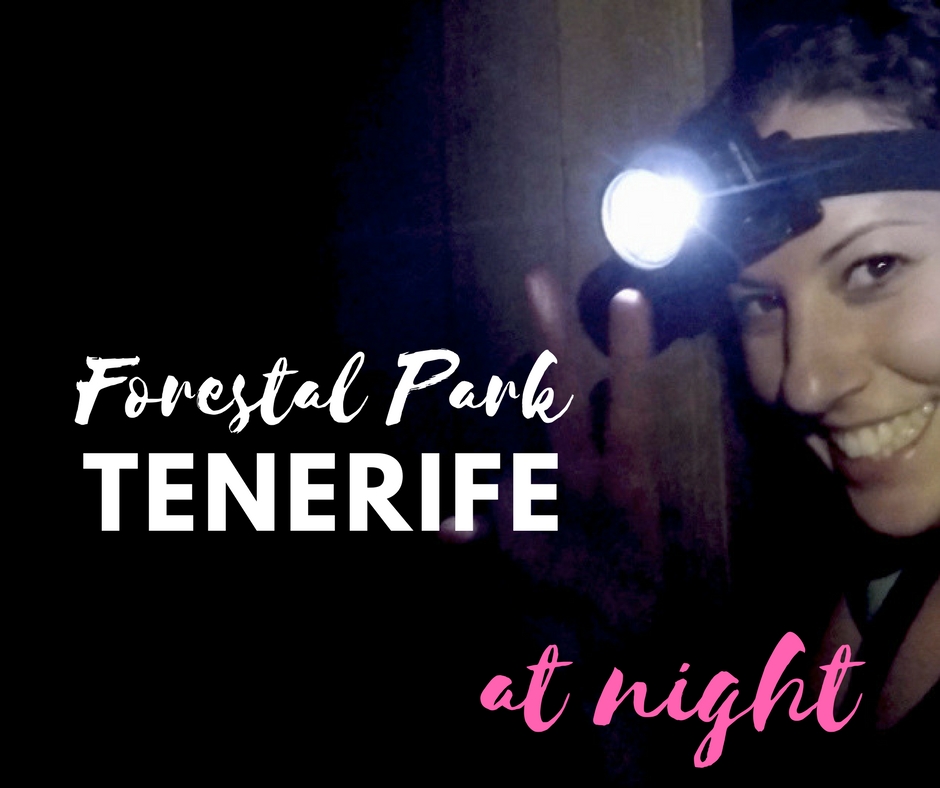
[updated] A few weeks ago, I had the great opportunity to be invited to the opening of Forestal Park Tenerife… at night! [icon icon=icon-moon size=14px color=#000 ] This adventure centre opens its doors all summer, every summer, to experience extreme sensations while up in the trees and with very low visibility. Ropes, zip-lines and lots of adrenaline. Are you in? Forestal Park has 86 different attractions, 11 of which are zip-lines, and are divided in different types of circuits. To start the activities, the team leaders will guide all users through one of their two briefing circuits, where the attractions, security procedures and doubts will be explained and resolved. Visitors will learn how to use the carabiners to always be at maximum security when away from the ground. Likewise, they will learn about climbing up and down from each game, how to cross them, and also the best posture to go down the zip-line. This step in compulsory for each participant – no exceptions. In the opening night, after some welcoming snacks, we split in two groups, and then went on the circuito deportivo (sporty circuit). It took us about three hours to complete it. We went on many different stations, reaching heights of 30 meters, and jumping off the longest zip-line in the park (and in the Canary Islands!), which is 230 meters long. This circuit is recommendable to all visitors who love feeling the adrenaline and who have no problems with heights. Nonetheless, all attractions have an escape way alternative in case users feel insecure once starting that phase of the circuit. To the adrenaline junkies like myself, I recommend you to keep moving forward and to experience the leap into the void… especially if you are able and willing to do it with no light at all. It is even better! The only disadvantage of doing this activity at night is the poor visibility, which is compensated by the head lamps. Everything else is just advantages: sensations are multiplied, you live a unique moment, adrenaline is double than during the daytime, emotions will make you feel goosebumps… the fresh air, Nature’s sounds, the lack of acoustic contamination, darkness, and even jumping without seeing where you are going… in my opinion, absolutely recommendable! If you want to live emotions and sensations, you just simply cannot miss this. Are you in? How to get there? The park is located on the road to el Teide via La Esperanza (close to La Laguna), at about 1400m, in the protected area of Las Lagunetas, being one of the most representative natural sites of the pinar canario (Canarian pines) in the Canary Islands. To easily get therefrom both South and North, you need to head towards La Laguna. Once in the area, go towards La Esperanza. You can go both by car or bus (aka: guagua, and the bus site of Titsa). From there, you’ll need to go by car or taxi (which you can take at Plaza del Adelantado, in La Esperanza). The GPS coordinates are: – Latitude: 28° 24′ 51.76″ N – Longitude: 16 ° 24′ 19.55″ O [su_gmap address=»Forestal Park Tenerife»] Recommendations – Bring warm and comfortable sports clothing. Preferably long (and not too loose) pants. – Bring sporty shoes. Preferably hiking boots or similar footwear, closed and tight. – Bring gloves (cycling style, leaving the fingers out). By doing so, your hands will be better protected from grazing against the ropes. – Check the weather. – Put up your hair in a ponytail or a braid. Loose hair is not allowed, due to security reasons. – Bring a small backpack for your personal belongings. There are no lockers, and bringing a small backpack is comfortable and does not graze or stop proper fitting of the harness. You’ll prevent losing your things when up high, or being harmed by them during your movements. The line of life The line of life is a security system created by Forest Experience, in which the adventurer is secured via carabiners to the circuit line, and that can only be modified when on land, before and after the activity. This way, even if an accident may happen, the user will always be safe and secure. Remarks This activity is not suitable for expecting mothers or people with functional physical diversity. Please, in case of having any questions, do not hesitate to contact Forestal Park Tenerife. Adventure is one of the biggest fascinations for humans. The best way to make a child enthusiastic about a new task is convincing him that it is an adventure. Later, enthusiasm for adventures will be the centre of life for many men and women. Special thanks to the director, Carmen, and to the team – especially José and Airam, for sharing their advice and stories. [spoiler alert: VIDEO coming up] (Check out more must-do activities in Tenerife)
Kayaking in Tenerife
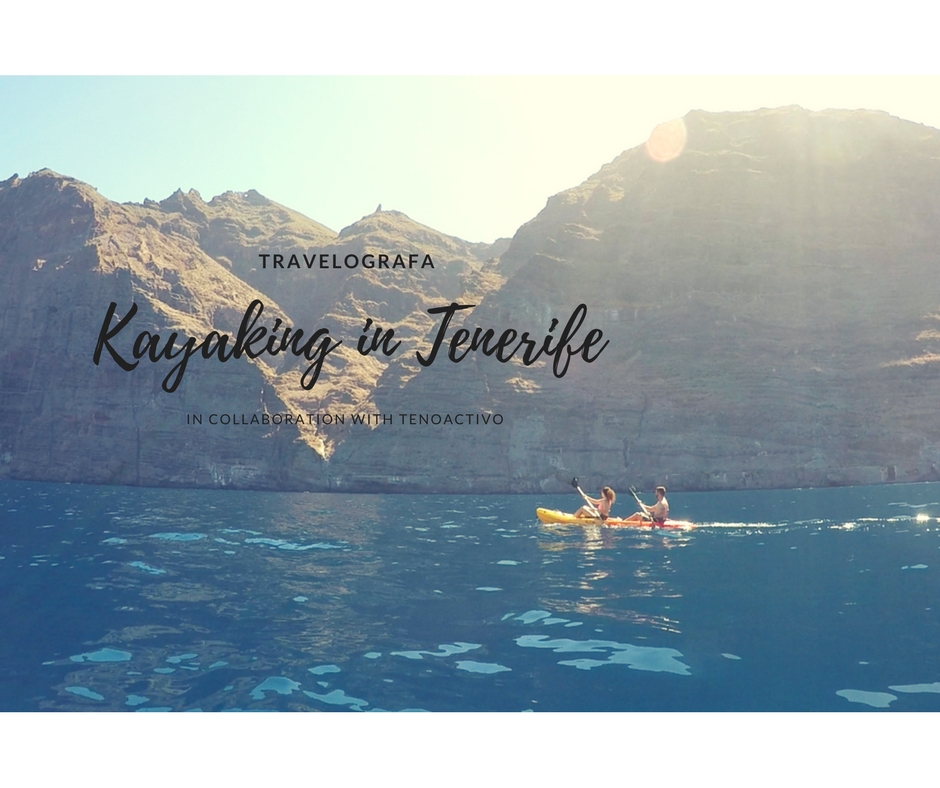
As I mentioned in the post top 9 must-do activities in Tenerife, kayaking in Tenerife is one of my top experiences. We decided to go to Los Gigantes -an unmissable spot- and slide its waters, parallel to these impressive cliffs, guided by Teno Activo, a top local business, leader on these kind of activities. Did you know that the Acantilados de Los Gigantes (the cliffs) are 12 kms away from Teno? Did you know that Los Gigantes and Anaga were the first places of the island to surface? The guide that lead our group told us these and many more interesting facts… Kayaking by the coast is an excellent activity to do when the ocean wants to show itself calm. This way, it doesn’t turn out to be a very exigent activity, while still keeping you active. You can look up and observe orography at its best. In the image below, you can spot the galleries created in the forties, to transport water from barranco to barranco (water-ways/ ravines). Nowadays, they’re hiking routes. The vertical lines, known as diques, were solidified first, becoming hard stone that takes longer to erode than the rest of the cliff’s wall. Just before jumping in the water, we stopped at the Bay of Echo. It is the only bay without a barranco, and should not be approached, as its wall elevates dangerously over the shore, increasing the consequences of a possible landslide. When separating from that point, still close to the cliffs and safe, a stop is made. There, you can have a snack and jump in the crystalline waters to freshen up. You can take your own gear -or enjoy the one provided by the company- to observe the bottom on the ocean, as the show continues underwater. This excursion is for all ages. We had two guides: one that was next to us, also kayaking, and telling us #funfacts about the area; and another one that went on a boat. The later would check the state of the coast, look for dangers and keep us all safe in case of an emergency; and of course, to close the group, controlling everyone’s on his sight. Also, he’s the one carrying the snacks, so he knows everybody will pay attention to him 😉 Undoubtedly, a little trip to take and repeat (not my first time, not my last 🙂 ). [su_youtube url=»https://youtu.be/AAnl656aMAA»] Do you want to book your excursion via travelOgrafa? Contact me here, and I will organize it for you! 🙂
Meteor showers 2017
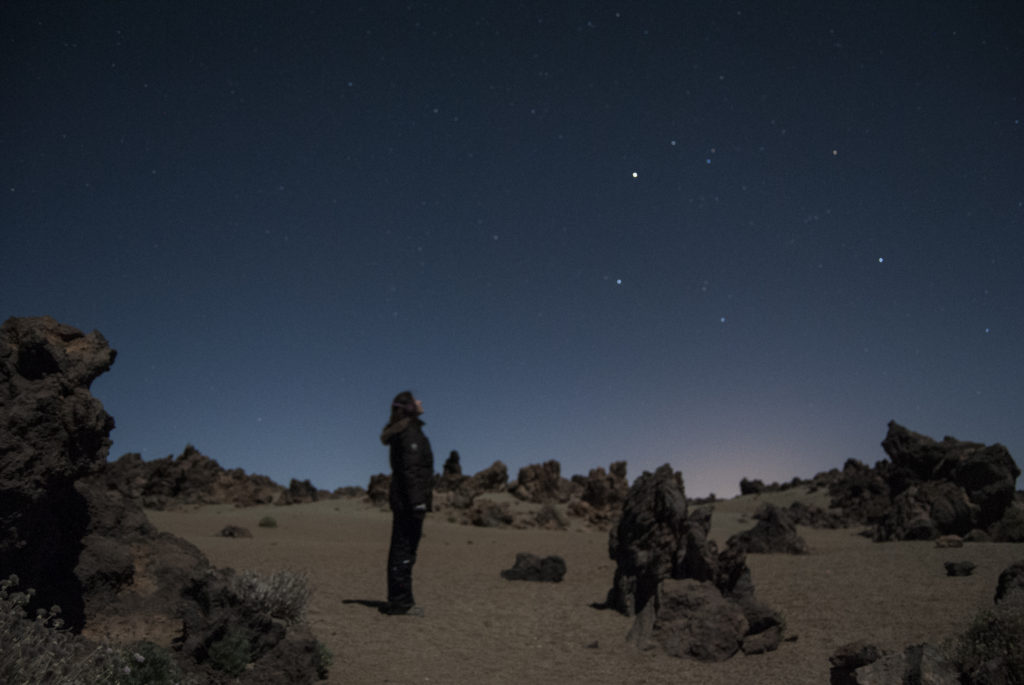
When someone states «I love the night», most people either reply with a strange look, thinking weirdo alert, or just asume that they are plain party people. In my case, it’s different. Since I was a little girl, I have been passionate about the skies. Clouds make me play with their form and variable shape, imagining what they could become in the next minute – will they be an animal? A monster? Or just show-off their beauty as if God just took a paint-brush to play for a little while, coloring the skies for us? And at night… the Moon, stars and planets have always captured my sight, fixing my gaze in the skies above, and thinking I like the night. To those who, like me, love photography of the night skies: get ready, take your tripod, your DSLR and lenses, some coating, and get to a spot with low photopollution, to capture this year’s meteor showers! 🙂 Meteor Showers of 2017 As you can see, three of the main meteor showers of this year have already taken place… but we still have some important ones to observe! The night with higher activity means that even though the shower is visible during all of the stated period, visibility of quantity of meteors stands out on the higher activity night. Likewise, the Moon phase will indicate the natural light pollution there will be. The more the Moon shines, the more light, the less visibility for stargazing. Therefore, the lower the percentage is, the better we will see the skies and constellations and meteors will be better captured with our lenses. This year, for example, Perseids will not be at their best, but Geminids will. 🙂 Radiant and constellation are used to get oriented on where the meteor shower is originated. Radiant is the spot where the stars shower from, the specific point in the sky, which is usually a constellation, which commonly names said shower. E.g. Perseids come from Perseus constellation, which is found 03h 04m, on +58º (there are Apps to calculate this 😉 ). To observe the skies, I use the Google App Sky Map, a free Android App to easily find constellations, planets, the Milky Way, and much more, learning about our beautiful sky. Do you like the night? 🙂 What else would you like to learn about the night sky and astrophotography? Enjoy 🙂 *Check out this article on things to do in Tenerife, amongst them, stargazing 😉
TOP activities to do in Tenerife
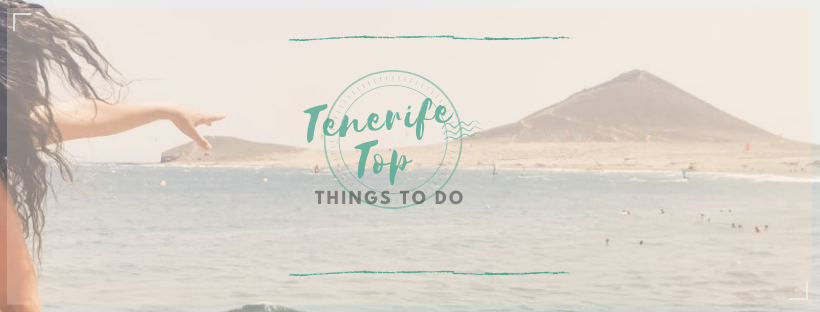
There are SO many activities to do on the island of Tenerife. I love number 9, so here, I introduce you to my top 9 must-do activities on the island. 1. Walk – hiking Walking can be done in many places throughout the island, with a vast variety of scenery and difficulty. I’d say go on the registered trails, as some can be dangerous to do by oneself without guidance. Also, please do not go alone, bring enough water, and follow the local recommendations. And, of course – enjoy!! 🙂 This is me a few years back, on the peak of Spain, on the island of Tenerife. Such an incredible, recommended hike – one of my most favorite ever. You get to an altitude of almost four thousand meters! It is also a super accessible hike, both getting to the trail, and moving between the mountain and the ocean shore. Imagine this: the same morning I was at the top of El Teide wearing my snow gear, I was sailing in my swimwear on the South coast. 2. Go underwater – diving/ freediving/ snorkeling I know, I know… this is not one but a group of activities… Whichever you choose, you need to explore the underwater life, the bottom of the Tenerife waters and its unique and endemic species. Please, do respect the fauna and flora around you – remember that you are the visitor; and apply the basic safety on all underwater activities, always going with a buddy and with the proper certification. Enjoy, being safe! I am a lover of the underwater world, and am passionate about these three sport disciplines. Are you in Tenerife and want to learn how to dive? Leave your comment below! I’ll teach you!* [click here to dive with me!] If you dive, please bring your diver ID, diver insurance, and make sure you have a dive buddy! (Also, if you need to know where to rent your material or book a nice dive, drop me a comment below!*). If you freedive, Tenerife will also be your paradise. International freediving championships are held each year on this Atlantic island, home of Apnea Academy West Europe, which welcomes Umberto Pelizzari each year. If you are keen to explore without getting too extreme, you can enjoy snorkeling! We have plenty of safe beaches and crystal clear spots to catch sight of the world below the surface. Check out this video of one of my most favorite organized adventures on the island! https://www.youtube.com/watch?v=ZlgcA4niGOg 3. Get under land – speleology Tenerife is home to some of the most amazing volcanic tubes in the World, and specifically to the longest one in Europe. Globally, it is only outstripped by some in the Hawaii islands. Visiting Cueva del Viento is a great approach to vulcanology, a magnificent way to get to know the island to its core. 🙂 4. Navigate the skies – paragliding In Tenerife, there are several spots to jump from and go paragliding. To the one who has never tried, I must say, it is an experience like no other. The nervousness one gets before jumping absolutely disappears once the feet are off the ground and you let yourself go. Suddenly, a feeling of tranquility and peace surrounds your body as you see the skies before you and the land under your feet. Tenerife is definitely a place to navigate the skies, be it for the first time, or one more to add to the check-list. (More adventure in the heights: Forestal Park Tenerife, at night!) 5. Taste – gastronomy Canarian food is something Canarians are very proud of, and we have strong reasons to be!! 🙂 Well, if you like eating and appreciate trying new flavors, that is! There are many dishes that are worth trying. Please, do so with the locals, in a Canarian restaurant, or in an authentic guachinche (a place where food is served, with a homey environment and similar to, although not-so-much, a restaurant). 6. Observe the stars – astronomy Being home to some of the best skies in the world*, the amazing firmament can be clearly viewed from many spots on the island. My favorite best is the National Park of El Teide. From up there, the Milky Way and wonderful constellations can be easily spotted throughout most of the year. Many tinerfeños (demonym for people from Tenerife) enjoy the Perseids Meteor Shower roughly every month of August, when el Llano de Ucanca becomes the playground for the night: Night photography at its best! *The Canary Islands are recognized as some of the best sky friendly and sky accessible locations in the world. They are one of the three best spots in the world to observe the sky, together with the Hawaii Islands and Chile. Also in these three locations, observatories are found, as well as the world giant telescopes. The island of La Palma holds the world’s largest single-aperture optical telescope, famous GranTeCan, Gran Telescopio de Canarias or GTC, of which Canarians also take pride. 7. Capture the beauty that surrounds you – photography When you’re a photography lover, you seek opportunities to embrace the beauty that surrounds you, be it landscape, be it people, be it Nature. In Tenerife you have the chance to practice your skills and to be involved with the environment that will undoubtedly welcome you and make you want to stay for longer. 8. Slide on the water – kayaking/ surfing Tenerife is home for international championships of many sports, amongst them, surfing. Apart from this, it is not only perfect for surfing and bodyboarding, but also for kayaking when/ where the Ocean waves are calmer. From Puerto de la Cruz or El Socorro in the North of the island, to Las Américas or El Médano in the South, waves show their sensual moves to excited surfers. And in places like Los Gigantes, the ocean remains peaceful to attract sliders to enjoy the coastline and even crystal clear waters. If you like the ocean, this is